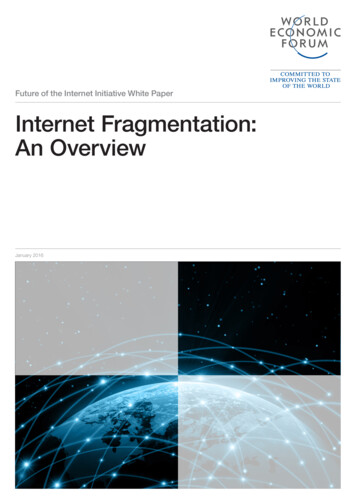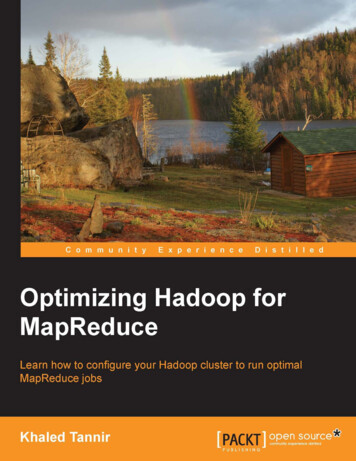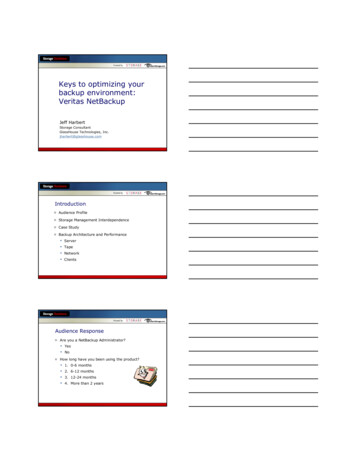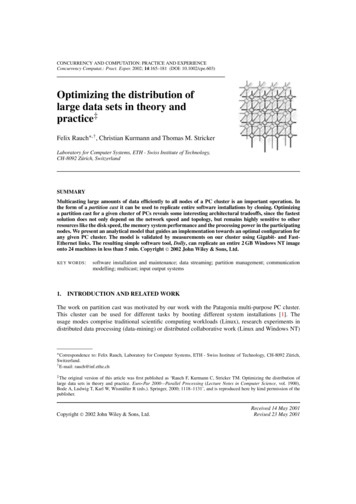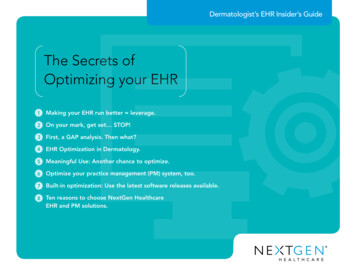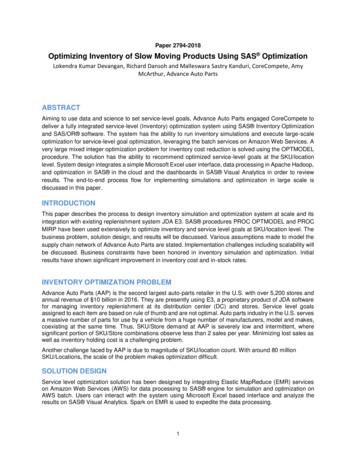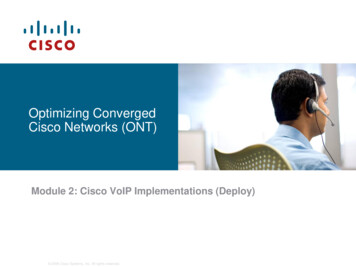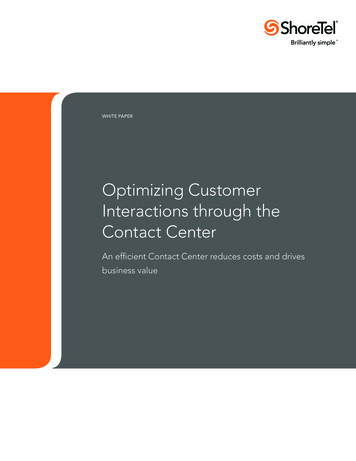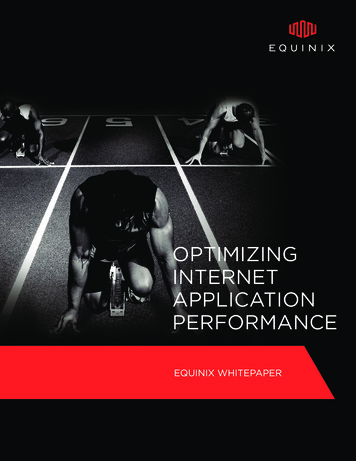
Transcription
OPTIMIZINGINTERNETAPPLICATIONPERFORMANCEEQUINIX WHITEPAPERGROW REVENUES SECTION/OTHER IMPORTANT INFO1
TABLE OF CONTENTSIntroduction.3Speed.4Availability & Consistency. 5Platform Equinix .6How Do We Test Application Performance?. 8Results.9Round Trip Time and Traceroutes. 9Availability and Predictability.10Takeaways. 11OPTIMIZING INTERNET APPLICATION PERFORMANCE TABLE OF CONTENTS2
OPTIMIZING INTERNETAPPLICATIONPERFORMANCEIn today’s digital economy, performance can be a strategic differentiator for yourcompany. Whether you’re a bank handling millions of clients online, a retailerdependent on your website to drive sales, or a cloud computing company poweringenterprises, performance-related end user experience is one of the key criteriaon which your company will be judged. There are numerous examples of howperformance can impact revenue: Amazon — “Every 100ms delay costs 1% of sales”1 — for 2009 thattranslates into 245 million Mozilla shaved 2.2 seconds of load time off its landing pages and increaseddownload conversions by 15.4%, translating into an additional 60 milliondownloads each year2 Microsoft found that an increase of 500ms of delays on its page loadsresulted in losing 1.2% in revenue per user3 When Shopzilla reduced its page load time by 5 seconds, it saw an increaseof 25% in page views and a 7-12% increase in revenue4 10ms latency could result in 10% less revenue for U.S. brokerages5Performance isn’t just about the speed of a site; availability and consistency are also important. Being able todeliver consistent, reliable service is fundamental to customer conversion and retention. From frustrated consumerstrying to buy gifts for Christmas to multinational companies attempting to do computational modeling, all types ofcustomers become frustrated when websites or cloud services aren’t fast or pages fail to load. Being able to provideyour customers a consistent experience, or in the case of the enterprise, to actually guarantee that performanceand consistency with a Service Level Agreement (SLA), translates to increased revenue by improving the end userexperience and reducing resistance from corporate buyers.In this paper, we describe how leveraging Equinix as the foundation for your services can reduce latency by 15%globally, reduce downtime by up to 80%, and increase predictability, all without having to invest the time or incur theexpense to change or redesign your application cationID 346OPTIMIZING INTERNET APPLICATION PERFORMANCE INTRODUCTION3
SPEEDThe speed of your site is judged on responsiveness to actions on the page (script requests, image renders, etc.) andon how quickly users can transition from page to page (loading a new page). The elements of speed can be furtherbroken down: the network latency and bandwidth between your end users and your site, the performance of yourserver infrastructure in responding to a request, and how quickly the user’s browser can render your site based onhow the web page is coded. While there is a tremendous body of knowledge on how to increase bandwidth, optimizeservers and code web pages, network latency is generally considered immutable. But new studies show that if youreduce latency, it will have a tremendous effect on page load times, even more so than bandwidth, with every 20msof reduced network latency resulting in a 7-15% decrease in page load times.6BENEFIT OF ADDINGAN EXTRA MBPSBENEFIT OFREDUCING RTT20%Percent reduction in idth (Mbps)121009148071660518422306%220Percent Improvement40%RTT (ms)PAGE LOAD TIME ASRTT DECREASESPage Load Time 0012001401601822020240500RTT (ms)Conventional advice on reducing latency recommends using a third-party provider such as a Content-DeliveryNetwork (CDN) to distribute content and leveraging their infrastructure to get geographically closer to the end user.While a CDN can help accelerate static content and effectively distribute video, the increasingly dynamic nature ofthe web (social media, real-time API access, etc.) reduces CDN effectiveness, and in a real-time cloud applicationmay not be able to help at all. This study shows how it is possible to reduce network latency across the internet byhousing application infrastructure in Equinix data centers and leveraging the unique network density located in them.6. esnt-matter-much/OPTIMIZING INTERNET APPLICATION PERFORMANCE SPEED4
AVAILABILITY & CONSISTENCYAvailability of a website isn’t solely dependent on how well you operate your infrastructure; it is also affected bythe performance of your internet service provider (ISP) and other service providers. Disputes between carriershave sometimes resulted in a fragmented internet, with some end users unable to access content while othersare unaffected.7 Likewise, achieving consistent site performance is based on an amalgamation of internal factors(e.g., proper capacity planning, load management) and external factors (e.g., internet performance, local traffic).Again, while the principles of optimizing the internal factors are well understood, how to optimize the external factorshas seemed to be a secret held by only the largest content providers such as Google or Amazon. In this whitepaperwe describe how these large content companies increase their control over external forces, and how your companycan reproduce this easily and cost effectively.The picture becomes clearer when viewed in light of the expansionpaths most favored by providers. 46% of respondents intended to expand primarily through partnerships, versus28% planning to grow organically, and 14% through acquisitions.7. MIZING INTERNET APPLICATION PERFORMANCE AVAILABILITY AND CONSISTENCY5
PLATFORM EQUINIX CDNs, content providers, and cloud providers choose Equinix as their data center services provider. Equinixprovides some of the most reliable, secure facilities in the world, and our long track record of delivering excellentservice has earned the trust of top companies’ CTOs and CIOs who know application performance is mission critical.But equally important, Equinix data centers are situated in critical locations throughout the internet, which enablesEquinix customers to optimize their end users’ experience. To understand how, let’s quickly review the structure ofthe internet.To the general public, the internet is a “cloud” they can plug into anywhere, but the fundamental structure of theinternet is actually drastically different. The internet is a vast series of interconnected networks that ride on thephysical capacity of hundreds of telecom providers. These networks overlap geographically (some major citieshave more than 50 networks), and they also share common characteristics.First, all ISPs architect their networks with backbone connections engineered as high-speed trunks between keynetwork nodes. Since these backbones are responsible for carrying massive amounts of data and distributing themacross the network, they are critical to each carrier. Therefore, carriers devote significant engineering and operationalresources to ensure the backbone runs as quickly and with as little contention as possible. By contrast, the regionalcoverage or non-backbone networks built by that same ISP may have some degree of oversubscription, resulting inunpredictable behavior and network congestion.Second, the physical cables forming these backbone networks generally converge on certain locations due to populationdensity and geographic limitations. In addition, sub-sea cables that connect the world’s continents reach the shore atvery distinct locations based on geographic characteristics (away from shipping lanes to prevent cable cuts, but stillnear major cities), resulting in placement similar or identical to where ISPs locate their backbone networks.Map of Undersea Fiber Optic CablesOPTIMIZING INTERNET APPLICATION PERFORMANCE PLATFORM EQUINIX6
Third, ISPs must have commercial agreements with each other to pass traffic, and physically connect backboneswith each other to accomplish this. The locations where the backbones tie together, also known as peering points,are the bridge between carriers. Thus, a route between two computers connected to different carriers might not bethe shortest possible route: data sent from a computer in Boston to a computer in Maine may go through a peeringpoint in New York. The implications become even greater in Asia, where a PC in Singapore trying to reach Sydneymay be routed through Los Angeles, transiting the Pacific Ocean twice. These types of routing inefficiencies canhave devastating consequences on performance.TYPICAL ROUTETO END USER6HOPS7CUSTOMERHOPS6HOPSOPTIMAL ROUTETO END USER3HOPSACUSTOMER4BHOPSC4HOPSEquinix’s data centers were built to act as the major peering points for ISPs, and our founding principle is to serveas a neutral location for carriers and their customers to meet and efficiently exchange traffic. Equinix is the onlyglobal provider of carrier-neutral data center services. More than 650 carriers connect with each other in our facilitiesaround the world, and the carrier connections to our facilities are their backbone links that expedite internet traffic.Equinix customers choose to build their infrastructure inside our data centers to ensure reliability and security, whileconnecting to the carriers they choose in order to leverage the world’s most reliable and efficient network routes.This allows businesses to mitigate the unpredictability of the internet by connecting directly to the ISPs their endusers use most often, whether a large cable broadband provider in the U.S., a French ISP, or a wireless provider forsmartphones. Because the physical speed limitations caused by geographical distances can also be a factor, Equinixhas built data centers all around the world, enabling our customers to locate their infrastructure as close to their endusers as possible. We call our combination of reliable data centers, located around the world, which contain dynamicecosystems of customers and networks “Platform Equinix.”OPTIMIZING INTERNET APPLICATION PERFORMANCE PLATFORM EQUINIX7
HOW DO WE TEST APPLICATIONPERFORMANCE?In collaboration with Compuware/Gomez, Equinix created a dedicated test platform to quantify the applicationperformance enabled by Platform Equinix. By building a “beacon server” connected to multiple carriers, Equinixsimulated the effects of different application routing scenarios—connected to only one carrier or connected to amultitude of carriers—using the same hardware, software and physical location to remove as many variables aspossible. In addition, to represent the impact of geographic diversity, Equinix replicated the beacon server at siteson the East Coast (Ashburn, Va.) and West Coast (Silicon Valley, Calif.). The beacon server was initially configuredto represent a typical server deployment with a connection to a single ISP in one location. The configuration wasthen connected with up to five carriers across multiple sites.Gomez, the web performance division of Compuware, provides the industry’s leading solution for testing theperformance, availability, and quality of web and mobile applications. The Gomez platform integrates web loadtesting, web performance management, web cross-browser testing, and web performance business analysis,enabling organizations to test from the “outside-in” across all users, browsers, devices, geographies, and datacenters. Gomez has created a unique monitoring solution that aligns with our attempt at representing real performanceacross the internet. Its Active Last Mile capability provides on-demand active monitoring from more than 150,000real, consumer-grade computers connected to over 2,500 local ISPs and wireless carriers in more than 168 countriesaround the globe.Gomez is the only solution able to provide an accurate view into the end user experience from anywhere on theinternet, anywhere in the world, on any carrier. In addition, the Gomez platform is extensible and flexible enoughfor Equinix to capture standard data, such as end-to-end connection time and availability, and also create customtraceroute scripts to provide visibility into actual network paths taken, by performing scripted routines using theirlast-mile network. The resulting data was parsed by removing outlying data (the bottom and top 2.5% of results forall tests), sorted by region and statistically analyzed to calculate variance (which translates into predictability).Equinix tested three key parameters: roundtrip time, traceroute, and availability. Roundtrip time represents the timeit takes to establish an initial connection to a server. This minimizes any differences in page rendering time, as wellas any potential concerns about database or back-end access. Differentials in roundtrip times can then be isolatedto correlate with network speed. The traceroute test counts how many network hops exist between the last-mile testnode and the beacon servers. Finally, availability data was collected from all global locations, which factors in thereliability of the internet as a whole .The Gomez Network:World’s Largest and MostComprehensive PerformanceMonitoring and TestingNetworkSource: /the-gomeznetwork/OPTIMIZING INTERNET APPLICATION PERFORMANCE HOW DO WE TEST APPLICATION PERFORMANCE?8
RESULTSWhen compared to a typical deployment, roundtrip time, traceroutes, and availability were all materially better in themulti-carrier, multi-node solution. In addition, predictability was improved across all three factors.One CarrierMulticarrierRound Trip TimeRoundtrip time was reduced 17%globally, in Asia-Pacific (APAC) bya striking 29% (65ms), Canadaby 24% (25ms), Latin America(LATAM) by 14% (22ms), U.S.by 11% (11ms), and EuropeMiddle East/Africa (EMEA) by7% (9ms).Using the modelingdone in other research8, with a20ms improvement representinga 7-15% drop in page load times,we can extrapolate the dramaticimprovements in performancepossible.APAC TotalCanadaEMEA TotalLATAM TotalUSGrand Total0.000.050.100.150.200.25SecondsOne CarrierMulticarrierTraceroutesTraceroutes depict how manydifferent routers a packet musttraverse on its way to the finaldestination. A more direct routemeans fewer points in the path forcongestion, failure, or variability. Byleveraging direct access to multiplecarriers in one Equinix facility, thenumber of hops to the beaconserver is dramatically reduced.Globally network hops decreasedby 24%, APAC decreased by 31%,EMEA by 27%, Canada by 21%,LATAM by 16%, and the U.S. by7%. This translates into more directconnectivity from your end users toyour servers.APAC TotalCanadaEMEA TotalLATAM TotalUSGrand Total4.06.08.010.012.014.016.018.0Network hops8. esnt-matter-much/OPTIMIZING INTERNET APPLICATION PERFORMANCE RESULTS9
One CarrierMulticarrierAvailabilityAvailability improvements achieved an81% reduction in downtime globally,translating into a drop from 11 to twohours of downtime in a year. Typically,availability measurements simply showwhether or not your site infrastructureis up and whether or not it is reachablefrom a single test node. By usingGomez’s Active Last Mile monitoring,we gain visibility into site availabilityfrom the end user’s perspective,factoring in whatever connectivityor availability issues their internetconnection might be introducing.This provides a more holistic view ofsite availability. By deploying in ouroptimized fashion, downtime in HongKong went from 50 to 0 hours, in UAEfrom 120 to 0 hours, and in the U.S.from 13 to 0 hours. For end users,this represents the difference betweenfailing to access your application andthe assurance they can access themreliably every time.APAC TotalCanadaEMEA TotalLATAM TotalUSGrand Total02.04.06.08.010.012.014.016.018.0Hours of downtime annuallyOne CarrierMulticarrierPredictabilityBy taking the standard deviationsfrom all the source data, we find 77%less variability in connection time,28% less variability in traceroutehops, and 23% less variability inavailability. Not only is performanceimproved across the board, butpredictability of that performance isalso increased dramatically.Standard DeviationEnd to EndStandard Deviationof TracerouteStandard Deviationof Availability00.51.01.52.02.53.03.54.0Standard deviationOPTIMIZING INTERNET APPLICATION PERFORMANCE RESULTS10
TAKEAWAYSHow difficult is it to implement the architecture we tested? Amazingly simple. As this study clearly demonstrates,where you locate your infrastructure plays a huge role in how well your site or application performs. Without anysoftware or server optimization, we were able to obtain significant improvements in performance by leveragingEquinix as a global interconnection hub. This represents a tremendous ROI compared to expensive softwareengineering efforts or infrastructure overhauls. By leveraging Platform Equinix, you can increase the performanceof your site by 15-20% and increase availability and predictability without having to redo any software or hardware.As studies have shown, performance is critical to the end user experience. A recent survey by Equation Researchshowed many consumers will abandon a website or company application that performs slowly9: Nearly one-third (32%) of consumers will start abandoning slow sites after one and five seconds. 39% of consumers say speed is more important than functionality for most websites, while only one infive ranked site functionality as more important. More than one-third (37%) of consumers said they would not return to a slow site, and 27 percent wouldlikely jump to a competitor’s site.Simply by colocating at the right data centers and being able to directly access multiple ISPs’ backbones, you canachieve the significant performance benefits that allow companies like Google or Microsoft to be fast for all usersindependent of their location. These performance improvements translate into measurable business benefits: Increased revenue for retailers More page views (and ad views) for content companies More satisfied customers for any type of site or applicationWhether your customers are regional or global, Equinix has data center services in the right locations to help youdramatically improve application performance to end DAMCHICAGOSILICONVALLEYBOSTONDENVERNEW YORKATLANTALOS LPHIAWASHINGTON, DCPARISGENEVAZURICHMIAMISHANGHAIMUNICHHONG KONGMILANSINGAPOREJAKARTADUBAIRIO DE JANEIROSÃO PAULOSYDNEYEquinix locationsPartner Data Center9. SpeedSurvey.pdfOPTIMIZING INTERNET APPLICATION PERFORMANCE TAKEAWAYS11
Corporate HQEMEAAsia-PacificEquinix, IncOne Lagoon Drive4th Fl
testing, web performance management, web cross-browser testing, and web performance business analysis, enabling organizations to test from the “outside-in” across all users, browsers, devices, geographies, and data centers. Gomez has created a unique monitoring solution that aligns with our attempt at representing real performance

